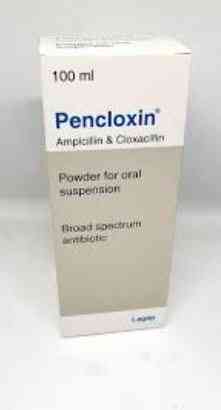What is PENCLOXIN
Information not available.
How to use PENCLOXIN
Information not available.
Mode of Action PENCLOXIN
Information not available.
PENCLOXIN Interactions PENCLOXIN
Information not available.
Dosage of PENCLOXIN
Information not available.
Possible side effects of PENCLOXIN
Information not available.
PENCLOXIN Contraindications PENCLOXIN
Information not available.
Storage of PENCLOXIN
Information not available.
PENCLOXIN features an exceptional active ingredient renowned for its potent effects, comprising Ampicillin, Cloxacillin. This powerful formulation provides a superior solution for addressing diverse health concerns. With 125mg, 125mg/5ml concentration and an easily manageable Suspension/Powder for, it remains a preferred option for countless individuals seeking effective treatment.
PENCLOXIN Suspension is a combination of two antibiotics, Ampicillin and Cloxacillin. It is commonly used to treat bacterial infections such as pneumonia, bronchitis, urinary tract infections, skin and soft tissue infections, and septicemia. The active ingredients in PENCLOXIN Suspension work by preventing bacteria from multiplying and spreading, allowing the body
s immune system to fight off the infection.
How does PENCLOXIN Suspension work?
PENCLOXIN Suspension contains Ampicillin and Cloxacillin as active ingredients. Ampicillin belongs to the penicillin group of antibiotics, while Cloxacillin is a type of penicillinase-resistant penicillin. Together, these antibiotics work by inhibiting the growth and multiplication of bacteria.
Ampicillin works by blocking the bacterial cell wall, preventing the bacteria from building and maintaining their cell structure. This ultimately leads to the death of the bacteria. On the other hand, Cloxacillin works by inhibiting the action of an enzyme called beta-lactamase, which is produced by some bacteria. Beta-lactamase breaks down certain types of antibiotics, including penicillins, making them ineffective. By inhibiting beta-lactamase, Cloxacillin enhances the activity of Ampicillin and other penicillins, making them more effective against bacteria that produce beta-lactamase.
Indications and Dosage of PENCLOXIN Suspension
PENCLOXIN Suspension is indicated for the treatment of a variety of bacterial infections, including respiratory tract infections, skin and soft tissue infections, urinary tract infections, and septicemia. It is important to note that PENCLOXIN Suspension should only be used for bacterial infections, as it is not effective against viral infections.
The dosage of PENCLOXIN Suspension is determined by the severity of the infection, the age and weight of the patient, and their overall health status. Generally, the recommended dose for adults is 250mg to 500mg of Ampicillin and Cloxacillin every 6 hours. For children, the dosage is usually calculated based on the childs weight, with a typical dose of 25mg to 50mg per kilogram of body weight, divided into 3 or 4 doses per day.
It is important to take PENCLOXIN Suspension as prescribed by your doctor, even if you start feeling better. Stopping the medication prematurely may result in incomplete treatment of the infection, which can lead to a relapse or the development of antibiotic-resistant bacteria.
Side Effects of PENCLOXIN Suspension
Like all medications, PENCLOXIN Suspension may cause side effects. The most common side effects of PENCLOXIN Suspension include:
Diarrhea
Nausea and vomiting
Abdominal pain
Skin rash
Allergic reactions
If you experience any of these side effects, it is important to contact your doctor immediately. In rare cases, PENCLOXIN Suspension may cause more serious side effects, such as severe allergic reactions, liver damage, and blood disorders. If you experience any of these symptoms, seek medical attention immediately.
Precautions and Warnings for PENCLOXIN Suspension
PENCLOXIN Suspension should be used with caution in patients with a history of allergic reactions to penicillins or other antibiotics. It should also be used with caution in patients with liver or kidney disease, as these organs are responsible for processing and eliminating the medication from the body.




0 Comments